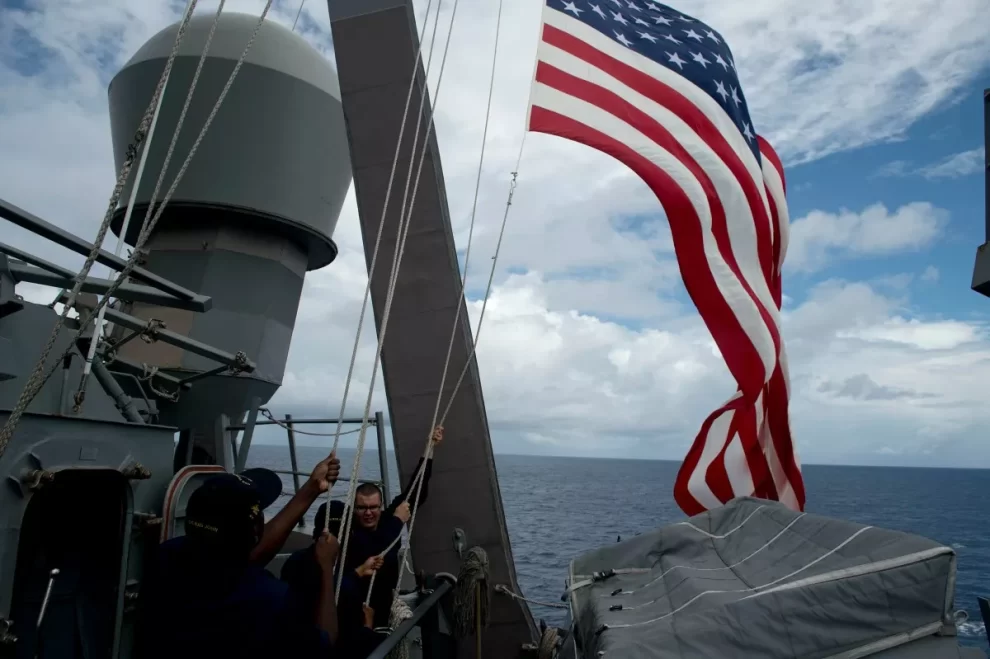With tensions simmering between China and the Philippines, the U.S. could be inching closer to a clash with Beijing in the South China Sea, a potential flash point in the key Asia-Pacific region.
On Sunday, Chinese ships blocked and then collided with two Philippine vessels close to the disputed Second Thomas Shoal. The Philippine boats were on a resupply mission to the BRP Sierra Madre, a wrecked warship hosting a number of Philippine troops as an outpost for Manila at the atoll.
China and the Philippines have long clashed over the contested area of the South China Sea, with Sunday’s collision marking the most recent confrontation. China, which refers to the Second Thomas Shoal as Ren’ai Jiao, has also laid claim to the atoll that falls under Manila’s exclusive economic zone.
Philippine Defense Minister Gilberto Teodoro accused the Chinese coastguard and Maritime Militia vessels of a “blatant violation of international law.” The Maritime Militia is made up largely of fishing vessels that Western assessments say help Beijing stake a claim to contested waters.

U.S. Navy personnel raise their flag during a bilateral maritime exercise between the Philippine Navy and U.S. Navy in the South China Sea on June 28, 2014. With tensions simmering between China and the Philippines, the U.S. could be inching closer to a confrontation with Beijing.NOEL CELIS/POOL/AFP VIA GETTY IMAGES
The Philippine boats “bumped dangerously” with the Chinese coastguard vessels and “Chinese fishing vessels,” Beijing said, according to Reuters. The Chinese coastguard described a “slight collision” between one of its boats and a Philippine vessel after the Chinese ship “lawfully” blocked Manila’s boat from carrying “illegal construction materials” to the warship, the outlet added.
Yet China’s problem is not just with the Philippines. The incident again involves Washington in a region already fraught with tensions over Taiwan as the U.S. increases its focus on China’s military build-up.
The U.S. State Department quickly said it “stands with our Philippine allies” against what it called “dangerous and unlawful actions” against the Philippine vessels. Washington also referenced a long-standing mutual defense treaty between the U.S. and the Philippines, adding the agreement “extends to armed attacks on Philippine armed forces, public vessels, and aircraft—including those of its Coast Guard —anywhere in the South China Sea.” Manila also said it was examining the 1951 pact following the incident.
China’s foreign ministry condemned the U.S. statement, saying Washington had “made baseless attacks against China’s legitimate and lawful law enforcement activities” at the Second Thomas Shoal, and a “sinister attempt to endorse the Philippines’ acts of infringement and provocation.”
“We deplore and reject it,” said Chinese foreign ministry spokesperson, Mao Ning.
Such incidents have been happening for many years but “haven’t yet spiraled out of control in a way that’s triggered a U.S. response,” according to Bryden Spurling, senior research leader in defense and security, at the European branch of the RAND think tank.
“But there is no doubt that they could also do so at any time,” he told Newsweek. “It only takes one incident, and there are forces at work right now that are pushing the region closer to, rather than further away from, that possibility.”
For the moment, it is likely these tensions will continue without “boiling over,” he said. Yet Beijing is hoping to push the U.S. out of the region, and is “trying incrementally to reach its goals, without actually triggering a conflict,” Spurling argued. Beijing may be at once reassured of its own maritime power, and seeing the U.S. diverted by a mix of domestic issues and the wars in Ukraine and between Israel and Hamas, he said.
China has poured massive resources into its Navy, swelling its size in a few short years—and it shows few signs of stopping. The U.S. has increasingly acknowledged China to be a primary threat to U.S. defense and security, not least with its upcoming Type 096 nuclear submarine.
Yet despite home-grown problems and international conflicts, the U.S. “still has enormous capability in the Indo-Pacific,” Spurling said, and a laser-focus on the threat it perceives in China. Washington “will want the region to be reassured that its security guarantees mean something, including its 1951 Treaty with the Philippines,” he added.
“We’re not losing sight of the fact that the department has identified China as the top pacing challenge,” a leading Pentagon official, Assistant Secretary of Defense for Indo-Pacific Security Affairs Ely Ratner, said earlier this week.
On October 19, the Pentagon released its annual China Military Power Report, in which it said China has “numerically the largest navy in the world,” featuring 370 ships and submarines. Within this tally, Beijing has more than 140 “major surface combatants,” the report said.
And if China emerges unsatisfied from encounters in the South China Sea and the Philippines can continue replenishing its outposts, Beijing “may feel it has to keep turning up the heat,” Spurling said. “At some point, it may push too far and trigger a localized Philippine or American response that then spirals into an escalation,” he warned.
“This is about the world as China would like it to be versus the world as the U.S. and its allies and partners would like it to be,” added Spurling.
Source : News Week










